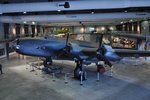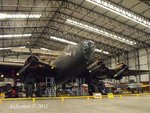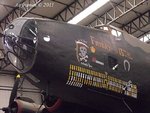Navigation
Install the app
How to install the app on iOS
Follow along with the video below to see how to install our site as a web app on your home screen.
Note: This feature may not be available in some browsers.
More options
You are using an out of date browser. It may not display this or other websites correctly.
You should upgrade or use an alternative browser.
You should upgrade or use an alternative browser.
Halifax, RCAF Museum Trenton,Canada
Ad: This forum contains affiliate links to products on Amazon and eBay. More information in Terms and rules
More options
Who Replied?Airframes
Benevolens Magister
Great stuff - and post as many more as you can please !
Wildcat
Major
Simply awesome!
Lovely shots!
Is that a real Halifax?
- Thread starter
- #7
Tracker
Senior Airman
Yes it is. It is the only one in North America. I have copied the following info from the National Air Force Museum. The history of the specific aircraft will be posted in a separate post.
Handley Page
Halifax, Mark VII
Tail #: NA 337 2-PX
Dimensions: Wingspan: 30.2m, Length: 21.4m
Max Weight: 25 000 kg
Max Speed: 450 km/h
Crew: approximately 7
Role: Bomber, ASW, Transport Glider Tug
In service: 1940-1945 (RAF RCAF)
with the museum since: 1996
The Handley Page Halifax was a vital component of the RAF Bomber Command's air offensive over German-occupied Europe during the Second World War. The National Air force Museum of Canada has the distinction of possessing the only Halifax aircraft in North America in its collection.
Handley Page
Halifax, Mark VII
Tail #: NA 337 2-PX
Dimensions: Wingspan: 30.2m, Length: 21.4m
Max Weight: 25 000 kg
Max Speed: 450 km/h
Crew: approximately 7
Role: Bomber, ASW, Transport Glider Tug
In service: 1940-1945 (RAF RCAF)
with the museum since: 1996
The Handley Page Halifax was a vital component of the RAF Bomber Command's air offensive over German-occupied Europe during the Second World War. The National Air force Museum of Canada has the distinction of possessing the only Halifax aircraft in North America in its collection.
- Thread starter
- #8
Tracker
Senior Airman
The History and Last Flight of NA337
The History of NA337
Halifax Mk VII, serial number NA337 was delivered to RAF's 644 Squadron at Tarrant Rushton, Dorset, England on 5 March 1945 and was given the squadron's identification code 2P-X. On 24 March 1945, NA337 took part in Operation Varsity, the last large-scale allied airborne operation of the Second World War: the crossing of the Rhine River. For this operation, it towed a Hamilcar glider that contained a Dodge truck and an artillery gun to be used by the army. Between 30 March and 24 April 1945, it participated in three supply drop operations to resistance forces in Denmark and Norway.
The Last Flight
The aircrew of Royal Air Force 644 Squadron flew together on numerous operations before being assigned to fly NA337.
On 23 April 1945, they took off from RAF Station Tarrant Rushton at 7:51 pm. It was on 'Operation Crop 17,' its mission was to deliver thirteen containers and two packages to Norwegian Resistance Forces just north-east of Oslo.
At 1:00 am, 24 April, the supplies were successfully dropped at the contact point in Miklesberget, and the pilot set course to return to England. NA337 was off course when it flew over the railway bridge at Minnesund, at the south end of Lake Mjøsa. Anti-aircraft fire from the enemy's defence battery hit the starboard wing. A 25mm explosive cannon shell ruptured one of the fuel cells. With the wing on fire, the pilot had no option but to land his aircraft on Lake Mjøsa, the only level area in the vicinity.
At 1:20 am NA337 was successfully ditched and the crew evacuated the aircraft, but because the dinghy did not deploy, the crew tried to swim to shore. Five of them perished in the cold water, with only the tail gunner Thomas Weightman, surviving the crash. In order to avoid reprisals, the local populace handed him over to the German Army. Two weeks later, however, the war ended and Flight Sergeant Weightman was liberated and returned to England.
Of those who perished, four are buried in the Lilliehammer Northern Civil Cemetery, Norway. The name of one missing member is inscribed on the RAF Memorial at Runnymede, England as having "no known grave". Thomas Weightman died in England in 2007.
The Crew:
Flight Lieutenant A Turnbull DFC 1918-1945 Pilot, from Edinburgh, Scotland
Flight Lieutenant WR Mitchell 1922-1945 Navigator, from East Dulwich, London
Flight Sergeant GR Tuckett 1922-1945 Bomb Aimer, from Cardiff, Wales
Flight Sergeant A Naylor 1923-1945 Radio Operator, from Cheekheaton, Yorkshire
Flight Sergeant GA Bassett 1911-1945 Flight Engineer, from West Cross, Swansea
Flight Sergeant TH Weightman 1910-2007 Air Gunner, from Northumberland
The Recovery
The Halifax Aircraft Association of Canada, looking for a suitable aircraft for their purpose, discovered that a Halifax aircraft, NA337, had been located in Lake Mjøsa. If it could be salvaged and restored to its original wartime condition, it would be a fitting tribute to those who lost their lives while serving their country.
Colonel L.A. Wright, the Canadian Air Attaché to Norway, and John Stene DFC and Bar, a Norwegian, arranged with the Norwegian government that full rights of salvage be granted to the Association.
The Dacon Subsea Salvage Company, who had developed a salvage plan, was awarded a contract in 1995 to raise the aircraft from the bottom of the lake. After many difficulties, caused by weather and equipment problems, the aircraft was successfully raised.
Colonel Roare Glenn, the Director of the Norwegian Air Museum at Gardermoen, arranged with the Norwegian Army to provide heavy equipment to move the aircraft onto the beach at Hias.
A team of technicians, from CFB/8 Wing Trenton, dismantled, cleaned and crated the aircraft components for shipment to the RCAF Memorial Museum for restoration.
The Restoration
A Restoration Team was formed in July 1995. The initial group consisted mainly of Air Force veterans but the arrival of the first components of Halifax NA337 generated curiosity, interest and enthusiasm. Retired aircraft technicians, tool and die makers, metal specialists, machinists and woodworkers offered to help. Others, who were skilled in outside fields, also volunteered. They included dentists, professional engineers, opticians, police officers, carpenters and even two Halifax pilots. Enthusiasts in Scotland (Rescue 57), Holland and England responded and assisted in finding the bits and pieces necessary to rebuild this Halifax.
During the first 18 months, work was carried out in many locations, including private homes and unoccupied buildings at CFB/8 Wing Trenton. In 1996, the project was consolidated and moved into a new addition to the museum. Materials, tools and machines were acquired from many diverse sources. Some Department of National Defence organizations were disbanding or modernizing; aircraft factories were retooling or downsizing. Often, obsolete machines that were donated were of the vintage used in the construction of this aircraft; the type that many of the volunteers used during their apprenticeships. However, the team did not have all of the skills and equipment necessary and needed outside support. Units of CFB Trenton had outstanding shops and facilities and, when available, freely provided assistance.
The Halifax Restoration Team contributed 350,000 man-hours to restore Halifax NA337. They leave, as a legacy, a magnificently restored aircraft, an excellent restoration capability and a skilled and well equipped organization which is capable of maintaining and restoring future aircraft and artefacts.
All info from National Air Force Museum Web site.
The History of NA337
Halifax Mk VII, serial number NA337 was delivered to RAF's 644 Squadron at Tarrant Rushton, Dorset, England on 5 March 1945 and was given the squadron's identification code 2P-X. On 24 March 1945, NA337 took part in Operation Varsity, the last large-scale allied airborne operation of the Second World War: the crossing of the Rhine River. For this operation, it towed a Hamilcar glider that contained a Dodge truck and an artillery gun to be used by the army. Between 30 March and 24 April 1945, it participated in three supply drop operations to resistance forces in Denmark and Norway.
The Last Flight
The aircrew of Royal Air Force 644 Squadron flew together on numerous operations before being assigned to fly NA337.
On 23 April 1945, they took off from RAF Station Tarrant Rushton at 7:51 pm. It was on 'Operation Crop 17,' its mission was to deliver thirteen containers and two packages to Norwegian Resistance Forces just north-east of Oslo.
At 1:00 am, 24 April, the supplies were successfully dropped at the contact point in Miklesberget, and the pilot set course to return to England. NA337 was off course when it flew over the railway bridge at Minnesund, at the south end of Lake Mjøsa. Anti-aircraft fire from the enemy's defence battery hit the starboard wing. A 25mm explosive cannon shell ruptured one of the fuel cells. With the wing on fire, the pilot had no option but to land his aircraft on Lake Mjøsa, the only level area in the vicinity.
At 1:20 am NA337 was successfully ditched and the crew evacuated the aircraft, but because the dinghy did not deploy, the crew tried to swim to shore. Five of them perished in the cold water, with only the tail gunner Thomas Weightman, surviving the crash. In order to avoid reprisals, the local populace handed him over to the German Army. Two weeks later, however, the war ended and Flight Sergeant Weightman was liberated and returned to England.
Of those who perished, four are buried in the Lilliehammer Northern Civil Cemetery, Norway. The name of one missing member is inscribed on the RAF Memorial at Runnymede, England as having "no known grave". Thomas Weightman died in England in 2007.
The Crew:
Flight Lieutenant A Turnbull DFC 1918-1945 Pilot, from Edinburgh, Scotland
Flight Lieutenant WR Mitchell 1922-1945 Navigator, from East Dulwich, London
Flight Sergeant GR Tuckett 1922-1945 Bomb Aimer, from Cardiff, Wales
Flight Sergeant A Naylor 1923-1945 Radio Operator, from Cheekheaton, Yorkshire
Flight Sergeant GA Bassett 1911-1945 Flight Engineer, from West Cross, Swansea
Flight Sergeant TH Weightman 1910-2007 Air Gunner, from Northumberland
The Recovery
The Halifax Aircraft Association of Canada, looking for a suitable aircraft for their purpose, discovered that a Halifax aircraft, NA337, had been located in Lake Mjøsa. If it could be salvaged and restored to its original wartime condition, it would be a fitting tribute to those who lost their lives while serving their country.
Colonel L.A. Wright, the Canadian Air Attaché to Norway, and John Stene DFC and Bar, a Norwegian, arranged with the Norwegian government that full rights of salvage be granted to the Association.
The Dacon Subsea Salvage Company, who had developed a salvage plan, was awarded a contract in 1995 to raise the aircraft from the bottom of the lake. After many difficulties, caused by weather and equipment problems, the aircraft was successfully raised.
Colonel Roare Glenn, the Director of the Norwegian Air Museum at Gardermoen, arranged with the Norwegian Army to provide heavy equipment to move the aircraft onto the beach at Hias.
A team of technicians, from CFB/8 Wing Trenton, dismantled, cleaned and crated the aircraft components for shipment to the RCAF Memorial Museum for restoration.
The Restoration
A Restoration Team was formed in July 1995. The initial group consisted mainly of Air Force veterans but the arrival of the first components of Halifax NA337 generated curiosity, interest and enthusiasm. Retired aircraft technicians, tool and die makers, metal specialists, machinists and woodworkers offered to help. Others, who were skilled in outside fields, also volunteered. They included dentists, professional engineers, opticians, police officers, carpenters and even two Halifax pilots. Enthusiasts in Scotland (Rescue 57), Holland and England responded and assisted in finding the bits and pieces necessary to rebuild this Halifax.
During the first 18 months, work was carried out in many locations, including private homes and unoccupied buildings at CFB/8 Wing Trenton. In 1996, the project was consolidated and moved into a new addition to the museum. Materials, tools and machines were acquired from many diverse sources. Some Department of National Defence organizations were disbanding or modernizing; aircraft factories were retooling or downsizing. Often, obsolete machines that were donated were of the vintage used in the construction of this aircraft; the type that many of the volunteers used during their apprenticeships. However, the team did not have all of the skills and equipment necessary and needed outside support. Units of CFB Trenton had outstanding shops and facilities and, when available, freely provided assistance.
The Halifax Restoration Team contributed 350,000 man-hours to restore Halifax NA337. They leave, as a legacy, a magnificently restored aircraft, an excellent restoration capability and a skilled and well equipped organization which is capable of maintaining and restoring future aircraft and artefacts.
All info from National Air Force Museum Web site.
Last edited:
AWESOME!
Airframes
Benevolens Magister
Great stuff !
The only other known surviving Halifax aircraft are the MkII raised from Lake Hocklingen in Norway in the 1970's, now on permanent display at the RAF Museum, Hendon, partially restored, but overall displayed as she looked when raised from the lake. Got a pic or two somewhere, but they're 35mm transparencies.
The other is the Halifax reproduction at the Yorkshire Air Museum, Elvington, UK, which was volunteer-built using the rear fuselage section of a Halifax recovered from one of the islands off the coast of Scotland, plus some other parts, and a Hastings wing and undercart, suitably cosmetically adapted, and reproduction interior with some genuine parts and fittings, as shown below.
The only other known surviving Halifax aircraft are the MkII raised from Lake Hocklingen in Norway in the 1970's, now on permanent display at the RAF Museum, Hendon, partially restored, but overall displayed as she looked when raised from the lake. Got a pic or two somewhere, but they're 35mm transparencies.
The other is the Halifax reproduction at the Yorkshire Air Museum, Elvington, UK, which was volunteer-built using the rear fuselage section of a Halifax recovered from one of the islands off the coast of Scotland, plus some other parts, and a Hastings wing and undercart, suitably cosmetically adapted, and reproduction interior with some genuine parts and fittings, as shown below.
Attachments
Crimea_River
Marshal
Yes it is. It is the only one in North America..
The only FINISHED one in North America, that is. We have another Halifax restoration project underway in Canada with parts at the Bomber Command Museum in Nanton, Alberta and also at Knox Tech in Ottawa but it will be a long process:
View: https://www.youtube.com/watch?v=v3mq57Atjfs
Last edited:
Airframes
Benevolens Magister
Ah, yes - I'd forgotten about that one. Good stuff Andy.
- Thread starter
- #13
Tracker
Senior Airman
I had not realized that the Halifax had a smaller bomb bay between the main bomb bay and the landing gear (each side). Does anyone know if it had a specialized use or just extra storage?
Airframes
Benevolens Magister
Yes, the wing-root bomb cells were used as bomb bays. There were actually three cells per side, and as far as I remember without checking, the capacity was a maximum of one 500lb bomb per cell, or equivalent max weight, such as SBC's of incendiaries, therefore a total of 3,000lb could be carried in the wing-root cells, in addition to the main, fuselage, bomb bay.
The Stirling had a similar arrangement.
The Stirling had a similar arrangement.
Last edited:
Users who are viewing this thread
Total: 1 (members: 0, guests: 1)



